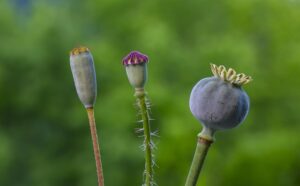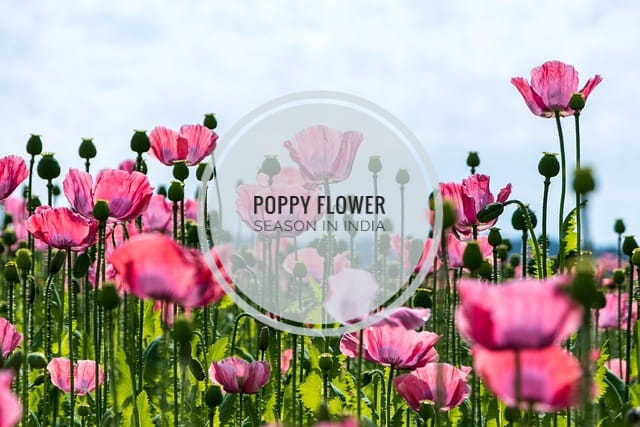Have you ever walked through a field of poppies and felt an instant sense of calm? The delicate petals, swaying gently, create a serene and colorful scene. If you’re curious about the poppy flower season in India, you’ve come to the right place.
This article will guide you through when poppies bloom, the different types, growing conditions, and much more.
Poppies are not only visually stunning but also carry historical and cultural significance. They have captured the imagination of gardeners, artists, and herbalists alike.
POPPY FLOWERS
Poppies are known for their bright, cup-shaped flowers that can be red, orange, pink, white, or even purple. They are cultivated in gardens, fields, and high-altitude regions across India. Understanding their blooming season is essential for gardeners who want to witness the full beauty of these flowers.

| Feature | Details |
|---|---|
| Botanical Name | Papaver spp. |
| Common Names | Poppy, Flanders Poppy, Oriental Poppy |
| Native Region | Europe, Asia, Mediterranean |
| Bloom Season in India | February to May (varies by region) |
| Height | 30–90 cm (varies by type) |
| Soil Type | Well-drained, loamy soil |
| Sunlight | Full sun |
| Watering Needs | Moderate, avoid waterlogging |
| Climate | Temperate to subtropical |
| Flower Colors | Red, pink, orange, white, purple |
HISTORY AND ORIGIN
Poppies have been cultivated for thousands of years, both for ornamental and medicinal purposes. In India, they are mainly found in temperate regions and high-altitude areas.
Historically, poppies were used for their seeds and oil. The opium poppy (Papaver somniferum) was grown for medicinal use in Ayurvedic medicine. Culturally, poppies symbolize peace, remembrance, and beauty.
The word “poppy” comes from the Latin papaver, referring to the bright, eye-catching flowers that stand out in cultivated fields.
GROWING CONDITIONS
Poppies require well-drained soil and plenty of sunlight. They do not thrive in waterlogged conditions. In India, they are mainly grown in:
- Himachal Pradesh and Uttarakhand – high-altitude, temperate climates
- Kashmir – cooler temperatures favor long-lasting blooms
- Rajasthan – certain varieties can tolerate warmer, drier conditions
Temperature: Most poppies prefer 10–25°C during their growing period.
Soil: Loamy, fertile soil with moderate drainage ensures robust growth. Adding compost improves flowering.
Watering: Keep the soil moist but avoid standing water. Too much water can rot the roots.
Sunlight: Full sun is essential for strong, healthy blooms.

POPPY FLOWER SEASON IN INDIA
Wondering when and where poppies bloom in India? Here’s a quick guide for all major regions and varieties. This table helps you plan visits or gardening schedules according to the season.
Table: Poppy Flower Season in India – Quick Guide
| Region / State | Bloom Months | Popular Varieties |
|---|---|---|
| Himachal Pradesh | February – May | Oriental Poppy, Himalayan Poppy, Opium Poppy |
| Uttarakhand | February – May | Himalayan Poppy, Flanders Poppy, Oriental Poppy |
| Kashmir | March – June | Himalayan Poppy, Opium Poppy, Flanders Poppy |
| Rajasthan | February – April | California Poppy, Opium Poppy |
| Sikkim & Darjeeling | March – May | Himalayan Poppy, Oriental Poppy |
| Maharashtra (Hill stations) | February – May | Oriental Poppy, Flanders Poppy |
| Punjab & Haryana | February – April | Opium Poppy, California Poppy |
VARIETIES OF POPPY FLOWERS
India is home to several poppy varieties, each with distinct features. Here are the most popular ones:
1. Oriental Poppy (Papaver orientale)
- Native Place: Europe and Western Asia
- Fruit Name: Capsule / Seed Pod
- Climate Type: Temperate
Large, brightly colored flowers, often red or orange, with delicate black centers.
2. California Poppy (Eschscholzia californica)
- Native Place: North America
- Fruit Name: Capsule
- Climate Type: Subtropical
Orange or yellow flowers, thrives in sunny Indian plains.
3. Himalayan Poppy (Meconopsis spp.)
- Native Place: Himalayas
- Fruit Name: Capsule
- Climate Type: Cool-temperate
Famous for striking blue flowers; requires cooler, high-altitude conditions.
4. Flanders Poppy (Papaver rhoeas)
- Native Place: Europe
- Fruit Name: Capsule
- Climate Type: Temperate
Bright red blooms, widely grown for ornamental fields in northern India.
5. Opium Poppy (Papaver somniferum)
- Native Place: Mediterranean and Asia
- Fruit Name: Capsule
- Climate Type: Temperate
Medicinal and ornamental uses; colors range from white to deep purple.

CARE TIPS FOR POPPY FLOWERS
Poppies are easy to maintain once you understand their basic growing needs. They respond best to good sunlight, moderate watering, and proper soil care. Here’s how to keep them healthy and blooming.
1. Sunlight
Poppies love bright light. They need at least 6 hours of direct sunlight daily for strong stems and vibrant flowers. In hilly areas, full morning sun and partial afternoon shade work best.
2. Watering
Keep the soil slightly moist, but never soggy. Overwatering leads to root rot and fungal diseases. Water once or twice a week, depending on the temperature. During flowering, reduce watering to avoid damaging delicate petals.
3. Soil and Fertilizer
Use well-drained loamy or sandy soil enriched with compost. Poppies dislike heavy clay soils. Add a balanced fertilizer or organic compost once a month during the growing season to encourage more blooms.
4. Temperature
Ideal temperatures range between 10°C and 25°C. Extreme heat can reduce flowering, so choose a cooler spot or partial shade in summer.
5. Pruning and Deadheading
Regularly remove dried or wilted flowers. This helps the plant focus its energy on new buds and prevents seed drop if you want a longer blooming season.
PROBLEMS & SOLUTIONS
Common pests and diseases include:
- Aphids: Spray mild insecticidal soap.
- Fungal infections: Avoid waterlogging and use fungicide if needed.
- Slugs and snails: Handpick or use safe organic repellents.
Proper spacing and sunlight reduce disease incidence.
USES AND BENEFITS
Poppies have multiple uses:
- Ornamental: Stunning addition to gardens, parks, and borders.
- Medicinal: Seeds and extracts used in traditional remedies.
- Culinary: Poppy seeds used in Indian sweets, breads, and cooking.
- Environmental: Attract pollinators like bees and butterflies.
DIFFERENCE BETWEEN POPPY FLOWER AND OPIUM POPPY
Many people wonder if the poppy flower and the opium poppy are the same. The truth is they belong to the same Papaver family, but not all poppies produce opium.
The opium poppy (Papaver somniferum) is the only variety that contains a milky latex in its seed pods. This latex is the natural source of opium, used for medicinal purposes under strict government control in India.
On the other hand, ornamental poppies such as the Oriental, Himalayan, or California poppy are purely decorative. They are grown for their bright colors, garden appeal, and edible seeds, with no narcotic content.
Table: Poppy Flower vs. Opium Poppy
| Feature | Poppy Flower (General) | Opium Poppy (Papaver somniferum) |
|---|---|---|
| Purpose | Ornamental, culinary, decorative | Medicinal, pharmaceutical |
| Latex Presence | Absent | Present in seed pods |
| Cultivation | Open for gardeners | Regulated by government |
| Common Colors | Red, orange, yellow, pink, white | White, lilac, purple |
| Uses | Beauty, seeds for cooking | Opium extraction, pain relief drugs |
This distinction is important for gardeners to understand before growing poppies, as only licensed farmers can cultivate opium poppies in India.
POPPY PRODUCTION IN INDIA
India is one of the major producers of poppies, primarily for seeds, oil, and ornamental cultivation. The main states cultivating poppies are Himachal Pradesh, Uttarakhand, Rajasthan, and parts of Punjab.
Commercial cultivation mostly focuses on the opium poppy (Papaver somniferum), grown under strict government regulations for medicinal and pharmaceutical purposes. Seeds from ornamental varieties are also harvested for culinary use and gardening.
Production Facts:
Himachal Pradesh & Uttarakhand: High-altitude regions with cooler temperatures produce early blooms and high-quality seeds.
Rajasthan: Drier climate supports ornamental poppy cultivation, especially California and Oriental poppies.
Punjab & Haryana: Grow poppies mainly for seeds used in Indian sweets and breads.
INTERESTING FACTS
- Some poppy seeds can remain viable for decades if stored correctly.
- Poppies are the symbol of remembrance in many cultures, including military.
- Himalayan poppies are extremely rare and require very specific conditions to bloom.
- The opium poppy has been cultivated for both ornamental and medicinal purposes for over 5,000 years.
- Poppies naturally disperse seeds by shaking their capsules in the wind, a mechanism called wind-dispersal.
FAQs
1. When does the poppy flower bloom in India?
The poppy flower season in India mainly spans from February to May, depending on the region and altitude.
2. Which regions have the longest poppy flowering season?
High-altitude areas like Himachal Pradesh, Uttarakhand, and Kashmir offer the longest bloom periods due to cooler temperatures.
3. Can poppies be grown in home gardens?
Yes, poppies can thrive in well-drained soil with full sunlight. Container gardening is also possible with regular care.
4. Are poppy seeds edible?
Yes, poppy seeds are widely used in Indian cuisine for sweets, bread, and as a garnish.
5. Do poppies need full sunlight?
Yes, at least 6 hours of direct sunlight daily ensures healthy flowering and strong stems.
CONCLUSION
The poppy flower season in India is a treat for gardeners and nature lovers alike. By choosing the right variety and region, anyone can enjoy these vibrant, delicate blooms. Poppies are easy to grow, beneficial, and add aesthetic and cultural value to gardens.
Thanks for reading. Keep growing, keep exploring, and don’t forget to return here at gardeningbud.com for more plants, tips and gardening wisdom.
